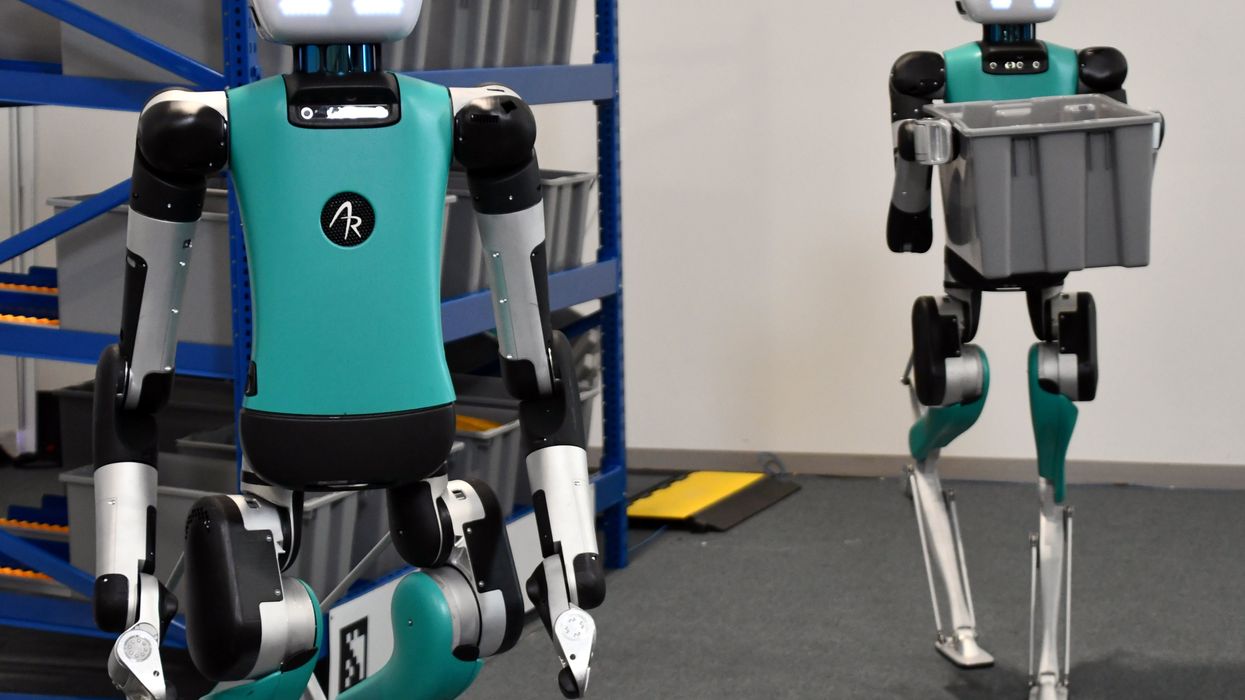Agility’s Latest Digit Robot Prepares for Its First Job

This morning at the ProMat conference in Chicago, Agility Robotics is introducing the latest iteration of Digit, its bipedal multipurpose robot designed for near-term commercial success in warehouse and logistics operations. This version of Digit adds a head (for human-robot interaction) along with manipulators intended for the very first task that Digit will be performing, one that Agility hopes will be its entry point to a sustainable and profitable business bringing bipedal robots into the workplace.
So that's a bit of background, and if you want more, you should absolutely read the article that Agility CTO and cofounder Jonathan Hurst wrote for us in 2019 talking about the origins of this bipedal (not humanoid, mind you) robot. And now that you've finished reading that, here's a better look at the newest, fanciest version of Digit:
The most visually apparent change here is of course Digit's head, which either makes the robot look much more normal or a little strange depending on how much success you've had imagining the neck-mounted lidar on the previous version as a head. The design of Digit's head is carefully done-Digit is (again) a biped rather than a humanoid, in the sense that the head is not really intended to evoke a humanlike head, which is why it's decidedly sideways in a way that human heads generally aren't. But at the same time, the purpose of the head is to provide a human-robot interaction (HRI) focal point so that humans can naturally understand what Digit is doing. There's still work to be done here; we're told that this isn't the final version, but it's at the point where Agility can start working with customers to figure out what Digit needs to be using its head for in practice.
 Digit's hands are designed primarily for moving totes.Agility
Digit's hands are designed primarily for moving totes.Agility
Digit's new hands are designed to do one thing: move totes, which are the plastic bins that control the flow of goods in a warehouse. They're not especially humanlike, and they're not fancy, but they're exactly what Digit needs to do the job that it needs to do. This is that job:
Yup, that's it: moving totes from some shelves to a conveyor belt (and eventually, putting totes back on those shelves). It's not fancy or complicated and for a human, it's mind-numbingly simple. It's basically an automated process, except in a lot of warehouses, humans are doing the work that robots like Digit could be doing instead. Or, in many cases, humans aren't doing this work, because nobody actually wants these jobs and companies are having a lot of trouble filling these positions anyway.
For a robot, a task like this is not easy at all, especially when you throw legs into the mix. But you can see why the legs are necessary: they give Digit the same workspace as a human within approximately the same footprint as a human, which is a requirement if the goal is to take over from humans without requiring time-consuming and costly infrastructure changes. This gives Digit a lot of potential, as Agility points out in today's press release:
Digit is multipurpose, so it can execute a variety of tasks and adapt to many different workflows; a fleet of Digits will be able to switch between applications depending on current warehouse needs and seasonal shifts. Because Digit is also human-centric, meaning it is the size and shape of a human and is built to work in spaces designed for people, it is easy to deploy into existing warehouse operations and as-built infrastructure without costly retrofitting.
We should point out that while Digit is multipurpose in the sense that it can execute a variety of tasks, at the moment, it's just doing this one thing. And while this one thing certainly has value, the application is not yet ready for deployment, since there's a big gap between being able to do a task most of the time (which is where Digit is now) and being able to do a task robustly enough that someone will pay you for it (which is where Digit needs to get to). Agility has some real work to do, but the company is already launching a partner program for Digit's first commercial customers. And that's the other thing that has to happen here: At some point Agility has to make a whole bunch of robots, which is a huge challenge by itself. Rather than building a couple of robots at a time for friendly academics, Agility will need to build and deliver and support tens and eventually hundreds or thousands or billions of Digit units. No problem!
Turning a robot from a research project into a platform that can make money by doing useful work has never been easy. And doing this with a robot that's bipedal and is trying to do the same tasks as human workers has never been done before. It's increasingly obvious that someone will make it happen at some point, but it's hard to tell exactly when-if it's anything like autonomous cars, it's going to take way, way longer than it seems like it should. But with its partner program and a commitment to start manufacturing robots at scale soon, Agility is imposing an aggressive timeline on itself, with a plan to ship robots to its partners in early 2024, followed by general availability the following year.